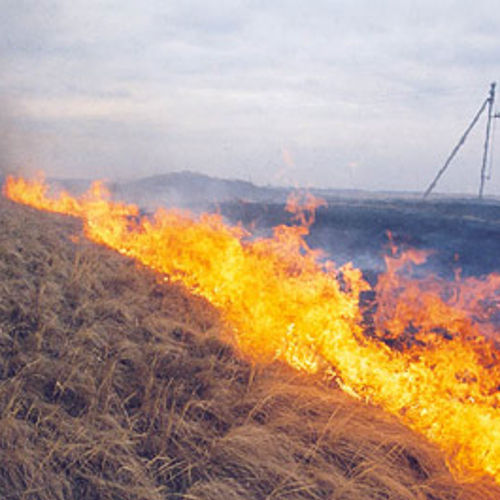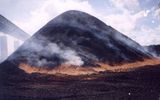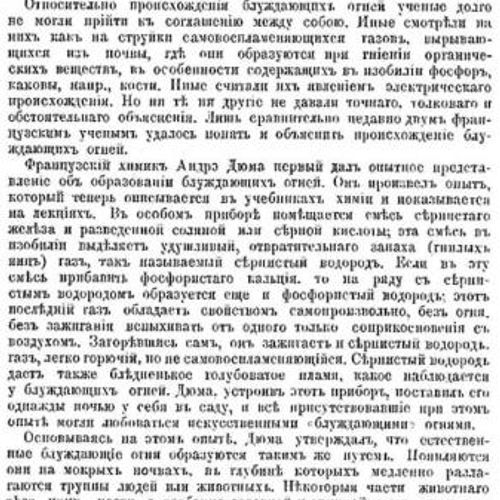
| Added | Wed, 12/10/2016 |
| Sources | Архипов В.А., Синогина Е.С. Горение и взрывы. Опасность и анализ последствий: Учебное пособие. Томск: Издательство Томского госу
№ 02/2006 журнала "Физика" издательского дома "Первое сентября"
|
| Феномены | |
| Version type |
Combustion is a complex physico-chemical process of transformation of the components of the combustible mixture in the combustion products with the release of thermal radiation, light and radiant energy. Approximately it is possible to describe the nature of combustion as rapidly ongoing oxidation.
Subsonic burning (deflagration) in contrast to the explosion and the detonation occurs at low speeds and is not associated with the formation of a shock wave. To subsonic combustion include normal laminar and turbulent flame propagation to a supersonic detonation.
Burning is divided into thermal and chain. In the basis of the heat of combustion is the chemical reaction that can occur with progressive samouskorenie due to the accumulation of heat is generated. Chain burning is found in the cases of some gas-phase reactions at low pressures.
The conditions of thermal self-acceleration can be achieved for all reactions with large heat effects and activation energies.
Burning could begin spontaneously as the result of spontaneous combustion either to be triggered by ignition. At fixed external conditions sustained combustion can occur in a stationary mode, when the main process characteristics – speed of response, power dissipation, temperature, and composition of the products is not changed in time, either in periodic mode, when these characteristics fluctuate around their average values. Due to the strong nonlinear dependence of the reaction rate on temperature, the combustion is highly sensitive to external conditions. The same property of burning determines the existence of several stationary regimes at the same conditions (hysteresis effect).
The following types of combustion: self-ignition, spontaneous combustion, flash, ignite, explosion.
Self-ignition – combustion arising from external heating of a substance to a certain temperature without the direct contact of combustible material with the flame of an external source of combustion.
Spontaneous combustion – the combustion of solids, arising from heating under the influence of processes taking place inside the substance. Occurring physical or chemical processes inside the substance associated with the formation of heat, which accelerates the oxidation process, turning into burning open fire.
Flash – fast, but rather with a Bang, briefly temporary combustion of the mixture of vapors of a combustible substance with air or oxygen resulting from a local increase of tempera tours, which can be caused by an electric spark or by touching the mixture of flame or namelennogo body. The temperature at which the outbreak occurs is called the flashpoint. The flash phenomenon similar to the phenomenon of the explosion, but, unlike the latter, it occurs without a strong sound and has no destructive action.
Ignition – resistant ignition of the mixture of gases and vapors of combustible material from a local temperature increase that can be caused by touching the flame or namelennogo body. Inflammation can last as long as will not burn the entire inventory of combustible material, and vaporization in this case is due to the heat released during combustion.
Ignition is different from flash for its duration. In addition, when the flash of heat in each phase is sufficient to ignite adjacent parcel already prepared the combustible mixture, but not enough to replenish it by a new evaporation amounts of fuel; therefore, having spent a stock of flammable vapors, the flame goes out and the flash ends, until the accumulated combustible vapors and will not receive local overheating. Upon ignition of the same evaporative substance is brought to such a temperature that the heat of combustion of the accumulated vapor is enough to restore the supply of the combustible mixture.
Explosion – instant combustion or decomposition of the substance, accompanied by the release of vast amounts of gases instantly expand and cause a rise in pressure in the environment. In contact with air: the gaseous products of decomposition of certain substances have the ability to ignite that not only leads to the destruction from the action of the blast wave, causes large fires.
Also allocate self-propagating high-temperature synthesis (SHS) is a chemical process that takes place with evolution of heat in avtovolnovye mode type of combustion and leading to the formation of solid products. SVS is a mode of exothermic reactions, where heat generation is localized in the layer and is transmitted from layer to layer by heat transfer.
So there was a fire, you need three factors:
- heat
- oxygen
- a combustible substance (fuel)
The meaning of the question is that only when these three components are present in proper proportion, it can create a flame.
There is also a flameless combustion. In contrast to conventional combustion, are observed when the zone of the oxidizing flame and reducing flame, it is possible to create conditions for flameless combustion. An example is the catalytic oxidation of organic substances on the surface of a suitable catalyst, for example, the oxidation of ethanol at platinum black.
Fire is uncontrolled burning out a special focus.
1. A combustible substance (fuel)
Flammable substances (materials) – substances (materials), interacting with the oxidant (oxygen) in the combustion mode. On the Flammability of substances (materials) are divided into three groups:
-
non-combustible substances and materials are not capable of self-combustion in air;
-
combustible substances and materials – the ability to burn in air when exposed to a supplementary energy source of ignition , but is not able independently to burn after its removal;
-
flammable substances and materials – is able to burn after ignition or auto-ignition combustion .
Flammable substances (materials) – relative concept, since non-standard techniques, low-combustible substances and materials are often combustible.
Among the combustibles are substances (materials) in different States of aggregation: gases, vapours, liquids, solids (materials), aerosols. Almost all organic chemical substances are combustible substances. Among inorganic chemicals also include flammable substances (hydrogen, ammonia, hydrides, sulfides, azides, and phosphides, ammirati different elements).
Flammable substances (materials) are characterized by indicators of fire danger. Introduction to the composition of these substances (materials) of various additives (promoters, flame retardants, inhibitors) can be changed in one way or the other indicators of fire danger.[3]
2. Oxidizer
The oxidizer is the other side of the triangle of combustion. Typically, the oxidant in combustion is the oxygen in the air, but can be other oxidizers - oxides of nitrogen, etc.
Critical exponent for oxygen as oxidant is its concentration in the air environment of the closed space of the ship in volume above 12-14%. Below this concentration, the absolute burning of most combustible materials does not occur. However, some flammable substances capable of burning and at lower concentrations of oxygen in the surrounding gas environment.
3. The temperature of ignition (heat)
There are many concepts that can be applied to temperatures which may ignite. Chief among them:
Flashpoint - the lowest temperature at which a substance emit enough flammable vapor to ignite when exposed to open flame, but the combustion does not continue.
Ignition temperature - the lowest temperature at which a substance gives enough flammable vapors to ignite and continue burning when an open flame.
Note. You can see that the difference between flash point and combustion temperature is that in the first case, there is an instant flash, and the second temperature should be high enough to produce enough flammable vapour for combustion, regardless of the source of ignition.
The ignition is a quick samouskorenie exothermic chemical reaction, causing the bright glow of fire. Ignition occurs due to the fact that the oxidation of the material with oxygen of air and gives more heat than time to play outside of the reactive system. For liquid and gaseous combustible substances that occurs when the critical parameters of temperature and pressure.
The intensity curve of the combustion
It is important to understand how typically developing fire. If we exclude the explosions and flare, the combustion process can be divided into the following four periods:
- a period of sunbathing
- fire development
- period burning
- the attenuation time
In this regard, it is significant that normally the fire propagated up very quickly, aside from a relatively low speed, and down - very slowly.
This can be illustrated as follows: If the fire originated (closed triangle), actions to extinguish the fire should be directed to withdraw the indices of the triangle (at least one) for the redistribution of critical values is to break the triangle of combustion. This is the theoretical basis of combustion and extinguishing.
Depending on the state of aggregation of combustible components (oxidizer or fuel) there are three kinds of burning.
-
Homogeneous combustion – the combustion of gases and gaseous combustibles in the environment of gaseous oxidizer.
-
Heterogeneous combustion – combustion of liquid and solid fuels (flammable substances) in the environment of gaseous oxidizer. A type of heterogeneous combustion is the combustion of liquid drops of fuel.
-
Combustion of explosives and propellants.
The speed of flame propagation combustion is divided into deflagration and detonation. Deflagration combustion is such a combustion mode, in which the flame propagates at subsonic speeds. When you knock, the flame propagates at a supersonic speed, for example, in air – at speeds over 300 m/s Subsonic combustion is divided into laminar and turbulent. The laminar burning velocity depends on the mixture composition, initial values of temperature and pressure, and the speed of chemical reactions in the flame. The speed of propagation of turbulent flames in addition to these factors depends on the flow velocity, the degree and scale of turbulence.
Auto-ignition, combustion occurs as the result of self-heating of combustible solid materials caused by samouskorenie they ectothermic. reactions. Spontaneous combustion is due to the fact that the dissipation in the course of the reactions more heat in the environment.
The beginning of spontaneous combustion is characterized by the self-heating temperature (TSN), which is a minimum in terms of experience, the temperature at which the heat dissipation is detected.
When reaching in the process of self-heating a certain temperature, called ignition temperature (Tcvos), there is a burning of the material, manifested either smoldering or flaming combustion. In the latter case, TSOs adequate auto-ignition temperature (TSV), which in case fire understand the emergence of burning gases and liquids when heated to some critical temperature. (see the fire in case fire). In principle, spontaneous combustion and self-ignition in the physical entity similar and differ only in the form of burning, self-ignition occurs only in the form of fiery burning.
In the case of self-ignition self-heating (heating of the preexplosive) develops within a few degrees and therefore will not be considered when assessing the fire and inflammation of gases and liquids. When the spontaneous combustion area of the self-heating can reach several hundred degrees (for example, peat from 70 to 225 °C). As a consequence, the phenomenon of self-heating is always taken into account in determining the propensity of solids to spontaneous combustion.
Spontaneous combustion is studied by incubation of the test material at a given temperature and establish the relationship between the temperature at which combustion occurs, the size of the sample and its heating time in the thermostat.
The processes occurring during the combustion of samples of combustible material shown in the figure. At temperatures up to TCH (eg. T1) the material is heated without change (the heat is missing). Upon reaching the TSN in the material occur exothermic reaction. Last, depending on the conditions of accumulation of warmth (weight of material, density of packing of its atoms and molecules, process duration, etc.) can, after a period of small self-heating upon exhaustion able to samoraspustitsya material components to complete cooling of the sample to the initial temperature of thermostat (curve 1) or to continue to camongrevis until Tcvos (curve 2). The area between TSN and TSOs potentially flammable, below TSN-safe.
The possibility of spontaneous combustion of material in potentially flammable region, established by means of the equations:

where tocr-ambient temperature, °C; l-determines the size (usually the thickness) of the material; t-time during which can occur spontaneous combustion; A1, n1 A2, n2 is the coefficient defined for each material for the experimental data.
According to the equation (1) for a given l find tocr, which may be spontaneous combustion of the material, by equation (2) is at a known tocr the value of T. At a temperature below the calculated tocr , or at t, less than the time calculated by equation (2), spontaneous combustion will not occur.
Depending on the nature of the initial process that caused self-heating of the material, and values of TSN distinguish spontaneous combustion:
- chemical
- microbiological
- heat
To chemical spontaneous combustion are exothermic interaction of substances (for example, when hit concentrated HNО3 on paper, sawdust, etc.). The most typical and common example of such a process - the spontaneous combustion of oily rags or other fibrous materials with a developed surface. Especially dangerous oil that contains compounds with unsaturated chemical bonds and are characterized by a high iodine number (cotton, sunflower, jute, etc.). The chemical phenomena of spontaneous combustion is the ignition of a number of substances (e.g., melkoistolchennym Al and Fe, Si hydrides, and certain metals, ORGANOMETALLIC compounds - alyuminiiorganicheskikh, etc.) in contact with air in the absence of heating. The ability of substances to spontaneous combustion under such conditions is called proforest. The pyrophoric feature of substances is that their TSOs (or TSV) below room temperature: - 200°C for SiH4, — 80 °C for A1(С2Н5)3. To prevent the chemical combustion of the shared storage of combustible substances and materials is strictly regulated.
There is also the view of the chemical reactions of substances associated with contact with water or moisture. It also stands out enough for spontaneous combustion of substances and materials temperature. Examples include substances such as potassium, sodium, calcium carbide, quicklime, etc. Feature of alkaline earth metals is their ability to burn without oxygen. Required for reaction of the oxygen they produce themselves, splitting under the action of high temperatures moisture in the air into hydrogen and oxygen. This is why the extinguishing water of such substances leads to an explosion of the generated hydrogen.
Prone to microbiological spontaneous combustion have combustible materials, especially hydrated, serve as the breeding ground for microorganisms associated with heat release (peat, sawdust, etc.). For this reason, a large number of explosions and fires occur during the storage of agricultural products (e.g., silage, moist hay) grain elevators. For microbiological and chemical self-ignition characterized by the fact that TSN does not exceed the usual values tocr and can be negative. Materials with TSN above the room temperature, able to heat spontaneous combustion.
The General tendency for all types of combustion have many solid materials with a developed surface (e.g., fibrous) as well as some liquid and melting of substances containing in its composition an unsaturated compound deposited on a developed (including non-flammable) surface. Calculation of critical conditions for chemical, microbiological and thermal combustion is carried out for equations (1) and (2).
Due to the attraction of the Earth when burning is occurring convection (air movement): the heated air becomes lighter and goes up and cold comes from below him. This flow of air causes a significant temperature gradient along the flame.

A schematic representation of a candle flame, indicating the temperature at various points when burning under normal conditions
Therefore, the flame of a candle in zero gravity is somewhat different:

The yellow-orange color the top of the flame under normal conditions due to the illumination of the particles of soot are carried up the ascending stream of hot air. Carbon black is microparticles containing carbon, failed to burn, i.e., to turn into CO2. In zero gravity a candle flame is smaller and not so hot, as usual, because there is not enough fresh air containing oxygen. Therefore, soot is very small, because it is not formed at temperatures below 1000 °C. But even if it was enough, and then because of the low temperature, she would Shine in the infrared range, and therefore, the color of flame in zero gravity always bluish.
The color of the flame depends on what elements are "burned" in it. High flame temperature allows the atoms to jump on some time in higher energy States, and then, returning to the original state to emit light of a certain frequency that corresponds to the structure of the electron shells of the element. For example, a gas burner burns with a blue flame due to the presence of CO, carbon monoxide, and the yellow-orange flame of a match to explain the presence of sodium salts in the wood.
The list of basic literature on the subject:
Main literature
1. B. Zeldovich, G. I., G. I. Barenblatt, V. B. Librovich, G. M., Makhviladze. The mathematical theory of combustion and explosion. M.: Nauka, 1980 478 p
2. V. V. Pomerantsev, K. M. Aref'ev, D. B. Akhmedov. fundamentals of applied theory of combustion. HP: Energoatomizdat, Leningrad. otd-s, 1986 – s. 309
3. A. M. Grishin, Mathematical modeling of forest fires and new ways of dealing with them. – Novosibirsk: Nauka, Sib. Otd-s, 1992. – 408 p
Further reading
1. The concept of development of combustion and explosion as a field of scientific and technical progress. Chernogolovka: Territoriya, 2001.
2. Alexeev B. V., Grishin A. M. lectures on aerothermochemistry. Part 1. Elements of kinetic theory, thermodynamics, and chemical kinetics. Part 2. The elements of the rigorous theory of the transport coefficients, the theory of energy transfer by radiation and the basic system of equations for aerothermochemistry. Tomsk: Publishing house Tom. Univ. 1971.
3. Volokitina A.V., Sofronov M. A. Classification and mapping of vegetation combustible materials. Novosibirsk: Izd-vo Nauka, Sib. otd-e RAS, 2002 – pp. 306
Translated by «Yandex.Translator»
Related facts
Related news
Related articles
Log in or register to post comments







